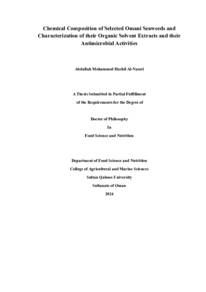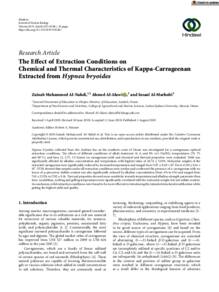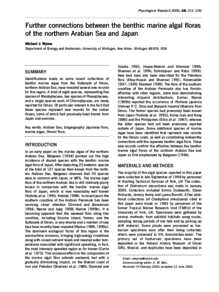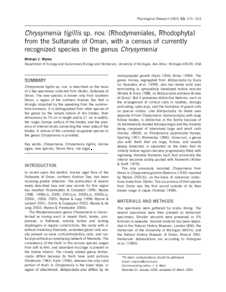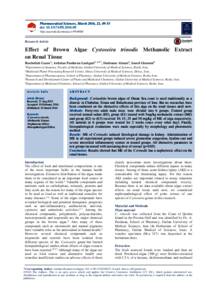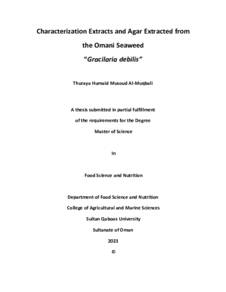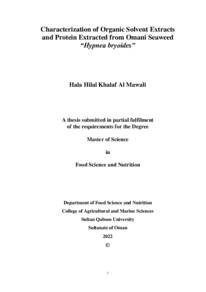Document
Chemical composition of selected Omani seaweeds and characterization of their organic solvent extracts and their antimicrobial activities.
Source
Doctoral dissertation
Other titles
تركيب أعشاب بحرية عمانية مختارة وتوصيف مستخلصات المذيبات العضوية وأنشطتها المضادة للميكروبات
Country
Oman
City
Muscat
Publisher
Sultan Qaboos University
Gregorian
2024
Language
English
Subject
Thesis Type
Doctoral dissertation
English abstract
Oman has a long coastline (~ 3, 165 km) with special environmental attributes such as
high salinity (range between 35.5 to 40 PSU), elevated temperatures, high light
intensity, and limited nutrients. During monsoon (Kareef), the southern part of Oman
(especially Dhofar province) experiences one of the biggest upwelling phenomena
worldwide, which brings with it high levels of nutrients, high waves, and colder water
temperatures, which influence the quality and composition of seaweed ingredients. In
addition, a comprehensive list of seaweeds in Oman showed 402 taxa, including several
species reported worldwide as potential sources of valuable ingredients, such as
carrageenan, agar, alginate, fucoidan, pigments, etc. Although the worldwide
production of seaweed has increased in response to the rise in demand, the full potential
of Omani seaweeds has not yet been studied. This study will open the door for more
intensive research in this field. Brown (Phaeophyceae), red (Rhodophyta), and green
(Chlorophyta) are the main categories of seaweed. Seaweed (multicellular autotrophic
organisms) classification is based on pigmentation content. Seaweeds are valuable
sources of bioactive compounds in biomedicine, cosmetics, food, and pharmacology.
This study aimed to determine the chemical composition, as well as bioactive and
antimicrobial properties of organic solvent extracts of the two red seaweed species
Melanothamnus somalensis & Gelidium omanense, and the two brown seaweed species
Jolyna furcate & Nizamuddinia zanardinii collected from the southern part of Oman
(Dhofar Province). Five organic solvents (hexane, dichloromethane, ethyl acetate,
acetone, and methanol) were used sequentially to achieve extraction. The chemical
composition included approximate composition, mineral profile, and protein quality;
whereas characterization work of the extracts included total phenolic content (TPC),
total flavonoid content (TFC), and total tannin content (TTC). The antimicrobial
investigation included several bacterial strains (Pseudomonas aeruginosa, Escherichia
coli, Klebsiella pneumonia, and Staphylococcus aureus) and one fungal strain (Candida
albicans) that are of global health concern. There were significant variations detected
in the chemical composition, TPC, TFC and TTC. The brown seaweed, Jolyna furcate
showed high protein, lipid, and carbohydrate contents compared to Nizamuddinia
zanardinii. However, Nizamuddinia zanardinii showed high ash and moisture contents.
Jolyna furcate showed higher mineral content, especially sodium, potassium calcium
and magnesium beside all macro-elements (hydrogen, nitrogen, and carbon).
Furthermore, Jolyna furcate had higher TPC in all fractions except the acetone fraction.
Except with dichloromethane, TFC in the other solvents’ extracts was high in
Nizamuddinia zanardinii. In all fractions, Jolyna furcate had high TTC. The red
seaweed Gelidium omanense showed high moisture, lipid, and carbohydrate compared
to Melanothamnus somalensis. However, Melanothamnus somalensis showed high ash
and protein contents compared to Gelidium omanense. Melanothamnus somalensis
showed higher mineral content, especially sodium and potassium. Furthermore,
Melanothamnus somalensis had higher TPC in all fractions except the hexane fraction.
Except with hexane, TFC in the other solvents’ extracts was significantly different
between Gelidium omanense and Melanothamnus somalensis. There were no
significant differences in TTC in all fractions, except dichloromethane and ethyl acetate
fractions. In addition, almost all samples in this study were free of heavy metals so they
could be used as food supplements for essential minerals and organic materials
according to recommended doses. Only the methanol extract of Nizamuddinia
zanardinii (MeNZ) showed interesting antimicrobial activity; the inhibition zone was
13 ± 1 mm. Furthermore, MeNZ was fractionated, and fraction 1 (MeNZ-F1) was
recognized to have antimicrobial activity; the inhibition zone was 14.66 ± 0.57 mm.
Stock concentration revealed higher activity against microbes in comparison with
diluted ones at three hours of incubation. TEM and SEM results showed that E. coli
treated with the active fraction had an irregular shape and rough surface, and leakage
of cellular content was observed. Furthermore, ribosomes were clustered and directed
toward the inner membrane of the bacteria, and the DNA clustered in the center of the
cell. Both seaweeds had high TPC, TFC, and TTC when compared with other seaweeds,
and this is in part because of the use of several solvents for extraction. Both seaweeds
were deficient in one or more of the essential amino acids. In addition, all samples in
this study were free of heavy metals so they could be used as food supplements for
essential minerals and organic materials according to recommended doses. In addition,
the methanol extract of Nizamuddinia zanardinii had good efficiency against
pathogenic bacteria and fungi. Therefore, it can be a noble constituent for the
improvement of antimicrobial drugs in the food and pharmaceutical industries.
Arabic abstract
تتمتع سلطنة عمان بساحل طويل )~ 3,165 كم( يتميز بخصائص بيئية خاصة مثل الملوحة العالية )تتراوح بين 35.5 إلى 40 وحدة PSU)، ودرجات الحرارة المرتفعة، وشدة الضوء العالية، والعناصر الغذائية المحدودة. أثناء الرياح الموسمية )الخريف(، يواجه الجزء الجنوبي من عمان )خاصة محافظة ظفار( واحدة من أكبر ظواهر ارتفاع مياه القاع إلى السطح في جميع أنحاء العالم، والتي تجلب معها مستويات عالية من العناصر الغذائية والامواج العالية ودرجات حرارة المياه الباردة، مما يؤثر على جودة وتكوين الاعشاب البحرية. بالاضافة إلى ذلك، أظهرت قائمة شاملة لألعشاب البحرية في ُعمان 402 تصنيفًا، بما في ذلك العديد من الانواع المثبت عنها عالميًا كمصدر محتمل للمكونات ذات قيمة، مثل الكاراجينان )carrageenan)، والاجار )agar)، والالجينات )alginate)، والفوكويدان )fucoidan)، والاصباغ )pigments)، وما إلى ذلك. وعلى الرغم من زيادة الانتاج العالمي من الاعشاب البحرية استجابةً الرتفاع الطلب، الا أن الامكانات الكاملة لألعشاب البحرية العمانية لم تتم دراستها بعد. وستفتح هذه الدراسة الباب لمزيد من البحث المكثف في هذا المجال. الاعشاب البنية )Phaeophyceae)، الاحمراء )Rhodophyta)، والاخضراء )Chlorophyta )هي الفئات الرئيسية للأعشاب البحرية. يعتمد تصنيف الاعشاب البحرية )الكائنات ذاتية التغذية متعددة الخاليا( على محتوى التصبغ. الاعشاب البحرية هي مصادر قيمة للمركبات النشطة بيولوجيا في الطب الحيوي ومستحضرات التجميل والمواد الغذائية والصيدلة. هدفت هذه الدراسة إلى تحديد التركيب الكيميائي، الخواص النشطة بيولوجيًا ومضادات الميكروبات لمستخلصات المذيبات العضوية لنوعين من الاعشاب البحرية الحمراء omanense Gelidium & somalensis Melanothamnus، ونوعين من الاعشاب البحرية البنية zanardinii Nizamuddinia & furcate Jolyna التي تم جمعها من الجزء الجنوبي من عمان )محافظة ظفار(. تم استخدام خمسة مذيبات عضوية )هكسان، وثنائي كلورو الميثان، وأسيتات الايثيل، والاسيتون، والميثانول( بالتتابع لتحقيق الاستخلاص. تضمن التركيب الكيميائي التركيب التقريبي، وملف المعادن، وجودة البروتين؛ في حين أن أعمال توصيف المستخلصات شملت المحتوى الفينولي الكلي )TPC ) والمحتوى الفلافونويدي الكلي )TFC )والمحتوى التانين الكلي )TTC). وشمل التحقيق المضاد للميكروبات العديد من السالالت البكتيرية )الزائفة الزنجارية، والاشريكية القولونية، والالتهاب الرئوي الكليبسيال، والمكورات العنقودية الذهبية( وسلالة فطرية واحدة )المبيضات البيضاء( ذات الاهتمام الصحي العالمي.
تم الكشف عن اختالفات كبيرة في التركيب الكيميائي، TPC، TFC وTTC. أظهرت العشبة البحرية البنية furcate Jolyna نسبة عالية من البروتين والدهون والكربوهيدرات مقارنة مع zanardinii Nizamuddinia. ومع ذلك، أظهر zanardinii Nizamuddinia نسبة عالية من الرماد والرطوبة. أظهرت furcate Jolyna ارتفاعا في المحتوى المعدني وخاصة الصوديوم والبوتاسيوم والكالسيوم والمغنيسيوم بالاضافة إلى جميع العناصر ً الكبرى )الهيدروجين والنيتروجين والكربون(. عالوة على ذلك، كان لدى furcate Jolyna محتوى من TPC أعلى في جميع المستخلصات باستثناء جزء الاسيتون. باستثناء ثنائي كلورو ميثان، كانت TFC الموجودة في مستخلصات المذيبات الاخرى مرتفعة في zanardinii Nizamuddinia. في جميع المستخلصات، كان لدى furcate Jolyna نسبة عالية من TTC. أظهرت العشبة البحرية الحمراء omanense Gelidium نسبة عالية من الرطوبة ومحتوى الدهون والكربوهيدرات مقارنة مع somalensis Melanothamnus. ومع ذلك، أظهر somalensis Melanothamnus نسبة عالية من الرماد والبروتين مقارنة مع omanense Gelidium. أظهر somalensis Melanothamnus محتوى معدني أعلى، وخاصة الصوديوم والبوتاسيوم. عالوة على ذلك، كان لدى somalensis Melanothamnus نسبة TPC أعلى في جميع المستخلصات باستثناء جزء الهكسان. باستثناء الهكسان، كان TFC الموجود في مستخلصات المذيبات الاخرى مختلفًا بشكل كبير بين omanense Gelidium وsomalensis Melanothamnus. في جميع المستخلصات، باستثناء كسور ثنائي كلورو ميثان وخالت الايثيل، لم تكن هناك فروق ذات داللة إحصائية في TTC. بالاضافة إلى ذلك، كانت جميع العينات تقريبًا في هذه الدراسة ا للجرعات خالية من المعادن الثقيلة، لذا يمكن استخدامها كمكمالت غذائية للمعادن الاساسية والمواد العضوية وفقً xi نشا مضادًا ًط الموصى بها. أظهر مستخلص الميثانول من (MeNZ (zanardinii Nizamuddinia فقط ا للميكروبات مثي ًرا لالهتمام، وكانت منطقة التثبيط 13 ± 1 مم. عالوة على ذلك، تم تجزئة MeNZ، وتم التعرف على الجزء 1 )1F-MeNZ )ليكون له نشاط مضاد للميكروبات؛ كانت منطقة التثبيط 14.66 ± 0.57 ملم. أظهر المحلول عالي التركيز عن نشاط أعلى ضد الميكروبات مقارنة بالتراكيز المخففة عند 3 ساعات من الحضانة . أظهرت نتائج TEM وSEM أن الاشريكية القولونية المعالجة بالجزء النشط كان لها شكل غير منتظم وسطح خشن، ولوحظ تسرب المحتوى الخلوي. عالوة على ذلك، كان هناك تجمع للريبوسومات وتوجهها نحو الغشاء الداخلي للبكتيريا، وتجمع الحمض النووي في وسط الخلية. بصورة عامة أحتوت كل من الاعشاب البحرية على نسبة عالية من TPC وTFC و TTC بالمقارنة مع الاعشاب البحرية الاخرى، ويرجع ذلك جزئيًا إلى استخدام العديد من المذيبات في الاستخلاص. كانت كلا الاعشاب البحرية تعاني من نقص في واحد أو أكثر من الاحماض الامينية الاساسية. بالاضافة إلى ذلك، كانت جميع العينات في هذه الدراسة خالية من المعادن الثقيلة بحيث يمكن استخدامها كمكمالت غذائية للمعادن الاساسية والمواد العضوية حسب الجرعات الموصى بها. بالاضافة إلى ذلك، كان لمستخلص الميثانول لنبات zanardinii Nizamuddinia كفاءة جيدة ضد البكتيريا والفطريات المسببة للأمراض. لذلك، يمكن أن يكون مكونًا واعدا لتحسين أو تطوير الادوية المضادة للميكروبات في الصناعات الغذائية والصيدالنية.
تم الكشف عن اختالفات كبيرة في التركيب الكيميائي، TPC، TFC وTTC. أظهرت العشبة البحرية البنية furcate Jolyna نسبة عالية من البروتين والدهون والكربوهيدرات مقارنة مع zanardinii Nizamuddinia. ومع ذلك، أظهر zanardinii Nizamuddinia نسبة عالية من الرماد والرطوبة. أظهرت furcate Jolyna ارتفاعا في المحتوى المعدني وخاصة الصوديوم والبوتاسيوم والكالسيوم والمغنيسيوم بالاضافة إلى جميع العناصر ً الكبرى )الهيدروجين والنيتروجين والكربون(. عالوة على ذلك، كان لدى furcate Jolyna محتوى من TPC أعلى في جميع المستخلصات باستثناء جزء الاسيتون. باستثناء ثنائي كلورو ميثان، كانت TFC الموجودة في مستخلصات المذيبات الاخرى مرتفعة في zanardinii Nizamuddinia. في جميع المستخلصات، كان لدى furcate Jolyna نسبة عالية من TTC. أظهرت العشبة البحرية الحمراء omanense Gelidium نسبة عالية من الرطوبة ومحتوى الدهون والكربوهيدرات مقارنة مع somalensis Melanothamnus. ومع ذلك، أظهر somalensis Melanothamnus نسبة عالية من الرماد والبروتين مقارنة مع omanense Gelidium. أظهر somalensis Melanothamnus محتوى معدني أعلى، وخاصة الصوديوم والبوتاسيوم. عالوة على ذلك، كان لدى somalensis Melanothamnus نسبة TPC أعلى في جميع المستخلصات باستثناء جزء الهكسان. باستثناء الهكسان، كان TFC الموجود في مستخلصات المذيبات الاخرى مختلفًا بشكل كبير بين omanense Gelidium وsomalensis Melanothamnus. في جميع المستخلصات، باستثناء كسور ثنائي كلورو ميثان وخالت الايثيل، لم تكن هناك فروق ذات داللة إحصائية في TTC. بالاضافة إلى ذلك، كانت جميع العينات تقريبًا في هذه الدراسة ا للجرعات خالية من المعادن الثقيلة، لذا يمكن استخدامها كمكمالت غذائية للمعادن الاساسية والمواد العضوية وفقً xi نشا مضادًا ًط الموصى بها. أظهر مستخلص الميثانول من (MeNZ (zanardinii Nizamuddinia فقط ا للميكروبات مثي ًرا لالهتمام، وكانت منطقة التثبيط 13 ± 1 مم. عالوة على ذلك، تم تجزئة MeNZ، وتم التعرف على الجزء 1 )1F-MeNZ )ليكون له نشاط مضاد للميكروبات؛ كانت منطقة التثبيط 14.66 ± 0.57 ملم. أظهر المحلول عالي التركيز عن نشاط أعلى ضد الميكروبات مقارنة بالتراكيز المخففة عند 3 ساعات من الحضانة . أظهرت نتائج TEM وSEM أن الاشريكية القولونية المعالجة بالجزء النشط كان لها شكل غير منتظم وسطح خشن، ولوحظ تسرب المحتوى الخلوي. عالوة على ذلك، كان هناك تجمع للريبوسومات وتوجهها نحو الغشاء الداخلي للبكتيريا، وتجمع الحمض النووي في وسط الخلية. بصورة عامة أحتوت كل من الاعشاب البحرية على نسبة عالية من TPC وTFC و TTC بالمقارنة مع الاعشاب البحرية الاخرى، ويرجع ذلك جزئيًا إلى استخدام العديد من المذيبات في الاستخلاص. كانت كلا الاعشاب البحرية تعاني من نقص في واحد أو أكثر من الاحماض الامينية الاساسية. بالاضافة إلى ذلك، كانت جميع العينات في هذه الدراسة خالية من المعادن الثقيلة بحيث يمكن استخدامها كمكمالت غذائية للمعادن الاساسية والمواد العضوية حسب الجرعات الموصى بها. بالاضافة إلى ذلك، كان لمستخلص الميثانول لنبات zanardinii Nizamuddinia كفاءة جيدة ضد البكتيريا والفطريات المسببة للأمراض. لذلك، يمكن أن يكون مكونًا واعدا لتحسين أو تطوير الادوية المضادة للميكروبات في الصناعات الغذائية والصيدالنية.
Category
Theses and Dissertations

